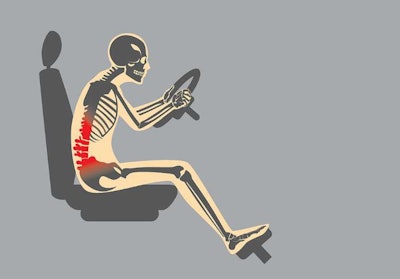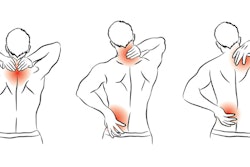
 Studies in recent years have shown uninterrupted stretches in a seated position are tied to serious health problems for truckers and desk workers alike.
Studies in recent years have shown uninterrupted stretches in a seated position are tied to serious health problems for truckers and desk workers alike.EDITOR’S NOTE: Being seated all day long is both a requirement of the job and one of the health concerns associated with driving a truck. This is a two-part series on the health issues associated with being seated for hours at a time and what you can do to deal with the problem. The second part appears on Truckers News tomorrow.
Simply sitting in the driver’s seat of a truck all day could be having serious consequences for your health.
Researchers have associated sedentary behavior with approximately 35 chronic diseases and conditions, The Wall Street Journal reported in 2015. Some problems are interrelated, many having to do with obesity, sleep apnea and poor circulation. More specifically, the list includes issues such as accelerated biological aging, nonalcoholic fatty liver disease and peripheral artery disease.
“I think truck drivers are at more risks than most because they’re sitting for that long period of time,” says Michael Gleiber, an orthopedic spine surgeon with the American Academy of Orthopedic Surgeons.
Millions of desk workers are also at risk, but they’re able to stand up whenever they wish. Some now even use stand-up desks. Truckers obviously don’t have that option.
A 2014 National Institute for Occupational Health and Safety (NIOHS) study of long-haul truck drivers classified 69 percent of survey respondents as obese. That’s more than 50 percent higher than rates among other workers. Obesity is linked directly to health concerns such as diabetes, heart disease and sleep apnea.
The same study found 80 percent of surveyed truck drivers reported they had at least one risk factor for chronic disease: hypertension, smoking or obesity. That number, too, is significantly higher than the comparable rate for all working adults: 54 percent. Nine percent of drivers said they had all three of the risk factors for chronic disease versus 2 percent for all workers.
While the NIOHS study didn’t specifically correlate truckers’ prolonged sitting with their high prevalence of obesity and heart disease, these health risks have been connected to sitting in other work environments.
“Being sedentary is a risk factor for obesity, and therefore for sleep apnea,” says Barbara Phillips, a medical doctor and professor in the University of Kentucky College of Medicine. Sleep apnea’s other risk factors include genetics, aging, cigarette smoking and more.
Sleep apnea, in turn, is associated with hypertension, stroke, heart rhythm problems, heart failure, coronary artery disease, impotence, depression and worsened diabetes control, says Phillips. Use of CPAP (continuous positive airway pressure) devices for sleep apnea usually reduces or normalizes these risks, she says.
Truckers also face greater incidence of the musculoskeletal problems that accompany excessive sitting. These include back and shoulder pain, arthritis and more. Prolonged sitting also increases the risk of deep vein thrombosis, which happens when a blood clot forms in a deep vein. This can lead to illness and disability.
“We found that when we had people sit for three hours in the laboratory that the functioning of the arteries in their legs went down to half within one hour and then stayed low for the remaining three hours,” says Saurabh Thosar, a researcher at Oregon Health & Science University.
Extended sitting also has been linked to metabolic syndrome, a group of factors that increases an individual’s risk for heart disease, diabetes, stroke and more. These factors include high triglyceride levels, low HDL cholesterol levels, high blood pressure, high fasting blood sugar and a larger waistline, according to the National Heart, Lung and Blood Institute.
In a separate recent survey of Overdrive and Truckers News readers, respondents were asked which equipment features were most important. Company drivers ranked high-quality seats above every other choice, including auxiliary power unit, late-model truck, large sleeper, satellite TV and other items.
Adjust your seating
Frequent and excessive vibrations, both large and small, can hurt not only your back but also your organs.
Custom seats with good shock absorption features can reduce those vibrations significantly. Custom seats offer varying degrees of support for the back and overall circulation through various adjustments and other features.
If you can’t make modifications because you drive a company truck, there are still things you can to do improve your current seat. Putting a rolled towel on the small of your back provides lumbar support. A towel or small pillow placed behind the neck can add support. Ensure your seat height, seat back incline and distance from pedals conforms to ideal positioning.
Jim Parison, chief engineer for Bose, spent a day in the 1990s riding with a tractor-trailer driver. He was appalled by how the driver was shaken around.
“It’s not a single bump that hurts the driver, it’s being shaken over time,” Parison says. The constant daily exposure to bouncing and more subtle vibrations results in “some problems with internal organs, like kidneys in particular,” Parison says. “Most truck drivers, by the time they’ve been driving for five years, have back problems. A lot of that is associated with the compromised position that their spine is in when they’re seated. All the shock that comes in and causes damage to their intervertical discs.”
Parison’s research led to the 2010 introduction of the Bose Ride system, a seat designed to counteract road vibrations.
Minimizer, known for its fenders and other truck products, also focused on countering excessive vibrations as it developed a seat in partnership with seat maker Isringhausen. Its Minimizer Long Haul Series, released in 2o16, includes six seats. The company released a report, based in part on research from chiropractic doctors Joseph Sweere and Michael Peterson, detailing how vibrations combined with other forces harm the lower back.
“Whole body vibrations increase the load on the spine, which causes muscles to become tired and sore,” the report says. “Pain increases fatigue. Numerous studies have shown that there is a correlation between whole body vibration and fatigue.”
Some European countries have regulations that limit how long workers can be exposed to such vibrations. The United States lacks similar regulations.
Fortunately, there are still things you can do outside of adjusting your seat that may lessen your risk for some of these sitting-related health issues. The second part of this series will walk you through practical ways to deal with the problem. Read the second installment in this series here.











